
Do you have a question about the LG Therma V ZHBW076A0 and is the answer not in the manual?
Safety guidelines for performing repair work on the unit, emphasizing specific hazards.
Procedures and checks to be performed after completing repair work on the unit.
Details on the various model names and their classifications within the product line.
Explanation of the model number nomenclature for factory and buyer models.
Table listing various model names with their corresponding heating/cooling capacities and power sources.
Visual representation of the included accessories and components with their quantities.
Diagrams illustrating the internal components of the cycle compartment for specific models.
Detailed technical specifications for different unit models, including capacity, power, and dimensions.
Table detailing the basic functions of the unit across different categories and models.
Overview of summarized features including emergency control and remote controller functions.
Explanation of special functions like lock settings for the remote controller to restrict operation.
Step-by-step guide on how to access and set the timer functions on the remote controller.
Instructions for setting a simple timer for the unit, specifying the adjustable range.
Guide on setting a reservation for the unit to automatically turn on at a specified time.
Guide on setting a reservation for the unit to automatically turn off at a specified time.
Details on setting exception days, DHW heating schedules, low noise mode, and screed drying.
Instructions for configuring system settings using DIP switches, including important cautions.
Explanation of DIP switch settings for Option Switch 2, detailing their functions and default values.
Details on the configuration options for DIP Switches 1 and 3, including MODBUS and sensor settings.
Defines terms like 'Trouble', 'Error', 'Emergency mode' and classifies troubles by severity.
Details on accessing and configuring service settings like service contact, model information, and version checks.
Step-by-step guide to inputting and editing the service center phone number in the unit's settings.
How to view indoor/outdoor product group and capacity information via the remote controller.
Instructions for checking the software version of the Remote Controller (RMC).
Information on how to access the open-source software license details for the remote controller.
Steps to enter the installer setting mode by inputting the correct password.
Detailed list of installer settings and their descriptions, covering various operational parameters.
Explanation of common settings like 3 Minutes Delay, temperature sensor selection, and Dry Contact Mode.
How to set temperature ranges for cooling and heating, with notes on water condensation.
Configuration for special DHW tank disinfection modes to prevent virus growth.
Details on tank settings including min/max temperatures, hysteresis, and heating priority.
Settings related to heater operation, water supply cutoff, and thermal on/off adjustments.
Covers pump settings, Smart Grid, seasonal temperature, data logging, password reset, and power supply blockage.
Explains heater priority logic and DHW time setting parameters, including timing charts.
Details on Modbus, CN_EXT, zone control, external pump, boiler, meter interface, and pump overrun settings.
Pre-test checks including refrigerant leakage and power/transmission cable connections.
Explains the basic principle of controlling motor RPM via compressor frequency and IPM.
Details on compressor control using fuzzy logic for stable system performance.
Explanation of the Electronic Expansion Valve (EEV) control mechanism for superheat and discharge pipe temperature.
Step-by-step guide for safely replacing the compressor, including disconnection and reconnection steps.
Instructions for replacing the Inverter Printed Circuit Board (PCB), including disassembly and assembly.
Important precautions for reassembling outdoor unit panels after replacement to prevent water ingress.
Guide for checking essential unit components to diagnose potential issues.
Explanation of the self-diagnosis system, including classified troubles and error indicators.
Comprehensive guide for troubleshooting common problems, referencing specific error codes.
Detailed troubleshooting flow chart and checks for the flow switch, including potential causes and solutions.
Troubleshooting steps for water pump issues, including wiring checks and PCB signal verification.
Troubleshooting guide for the electric heater, covering power supply, thermodisk, and relay issues.
FAQ addressing common remote controller issues like unresponsive buttons and automatic display changes.
Troubleshooting steps for compressor issues related to power, IPM, coil, and insulation resistance.
Guide for diagnosing fan motor problems, including power supply, wiring, and circuit board issues.
Explains the concept of classified troubles (slight, heavy, option) and emergency operation modes.
Description of error indicators (LEDs) on the Main PCB and Inverter PCB, and automatic restart behavior.
A list of error codes for the Main PCB assembly, detailing the cause and main reasons for each.
List of error codes for the Inverter PCB, including descriptions, LED indications, and main reasons.
Troubleshooting guide for sensor errors (remote room air, refrigerant inlet/outlet), including check points and flow charts.
Troubleshooting steps for communication errors between the wired remote controller and the unit PCB.
Diagnosis and countermeasures for bad communication between Main PCB (Inverter) and Main PCB (Heater).
Troubleshooting for water tank and solar-thermal sensor errors, including connection and resistance checks.
Procedure for checking PCB EEPROM for sum errors, including visual inspection and replacement guidance.
Troubleshooting flow chart and checks for flow switch errors, covering various states and conditions.
Diagnosis and countermeasures for water pipe overheating, including thermostat checks and system shutdown advice.
General error for sensor issues, referring to troubleshooting for specific sensor errors like 17, 18, 19.
Detailed troubleshooting for water inlet, outlet, and electric/heater water outlet sensor errors.
Troubleshooting for electric heater overheating, including thermostat checks and recommended service actions.
Diagnosis and countermeasures for DC Peak (IPM Fault) error, involving checks on installation and compressor components.
Troubleshooting for Max. C/T Input Over Current error, focusing on installation, wiring, and PCB checks.
Troubleshooting for DC Link Low Volt and High Volt errors, involving power connection and PCB checks.
Diagnosis for DC Compressor Position and Locking Detection errors, focusing on wiring and PCB checks.
Troubleshooting for inverter compressor over current, covering overload, damage, voltage, and PCB issues.
Diagnosis for high discharge pipe temperature, checking fan, refrigerant, EEV, and sensor status.
Troubleshooting for various sensor errors (D-pipe, Air, Condenser, Suction, Injection) including connection and resistance checks.
Troubleshooting for high pressure sensor errors, checking connection and sensor values.
Diagnosis for communication errors between Inverter and Main PCBs, involving power reset, connectors, and LEDs.
Troubleshooting for communication errors between Heater and Inverter PCBs, checking power, wiring, and resistance.
Troubleshooting for Reverse Phase Detection Error, focusing on power wiring and phase checks.
Troubleshooting for EEPROM check sum errors on Inverter and Main PCBs, including insertion and version checks.
Diagnosis for high condenser pipe temperature, checking fan, refrigerant, EEV, and sensor assembly.
Troubleshooting for heat sink temperature errors, involving screw torque, resistance, and thermal grease checks.
Diagnosis for fan lock errors, checking fan assembly, motor, wiring, and PCB.
Troubleshooting for AC Input Instant Over Current error, focusing on installation, voltage, wiring, and PCB checks.

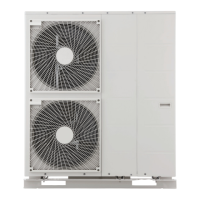






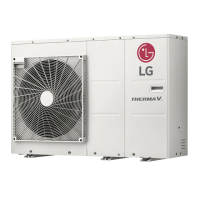
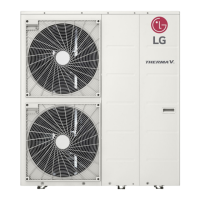
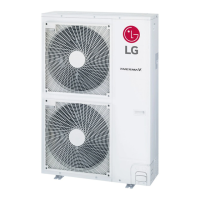
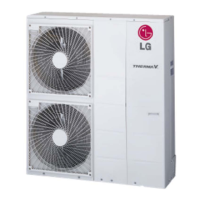
